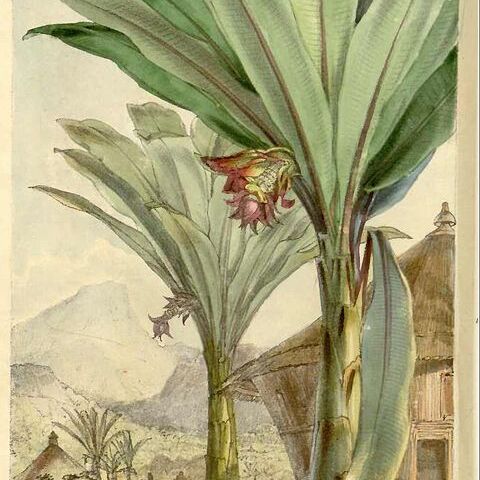Is the basis of an agricultural system in southern Ethiopia.. Giant herb arising from a short upright rhizome.. Pseudostem formed of the overlapping leaf-bases, 1.5-5 m. tall.. Leaf-blades erect or spreading, forming a large rosette, oblong-lanceolate, to 5 × 1.5 m., glaucous or not, midrib red or green.. Inflorescence appearing from the centre of the rosette, pendulous when mature.. Bracts of the male part of the inflorescence persistent or partially deciduous, each subtending ± 30-40 flowers.. Outer tepal of male flowers 3-lobed, the lobes variable in length, 3.5-5.5 cm. long, white with orange-yellow tips; inner tepal serrate-apiculate, 1-1.5 × 1-1.7 cm., the apiculum 0.3-1.3 cm., or occasionally absent; stamens 5, 3-5 cm. long, anthers violet to purple, filaments white; staminode present or not, acicular, 0.1-1 cm. long; style acicular, 1-2 cm. long.. Bracts of the female/hermaphrodite part of the inflorescence persistent, partially covering the fruits.. Outer tepal 3-lobed, sometimes with 1-2 smaller extra acicular lobes attached to it internally; inner tepals 1-3, variable in shape with 2 wings and an apiculum up to 1.5 cm. long; stamens 0-5, 3.5 cm. long, coloured as in the male flowers; staminodes variable according to the number of stamens present; style 2.5-4 cm. long, terete, with a large capitate stigma.. Fruits 5-20 in the axil of each bract, long-obovoid, 8-15 × 3-4.5 cm., orange at maturity.. Seeds irregularly subspherical, 1.2-2.3 × 1.2-1.8 × 0.9-1.6 cm., striate to smooth, hard, black, embedded in orange pulp.. Fig. 1.
More
A banana like plant. It grows to 6-12 m high. The lower part of the leafy false stem is swollen. Many different varieties exist. The leaves are bright green with an obvious red midrib. The leaves can be 5 m long and 0.9 m wide. The flower is a very large hanging spike. It is 2-3 m long. The flowers are cream coloured. There is a single petal in a large red bract. The fruit resemble small bananas. They are 6-8 cm long and 3 cm thick. They have a yellow skin. The seeds are pea like and fill the fruit. The seeds are black and about 6 mm across. There are 50 cultivated types.
Large, fleshy tree, up to 12 m high, with a head of banana-like leaves. Leaves 2-5 x 1 m, midrib rose-pink. Flowers in massive, pendulous racemes, protected by large, saucer-shaped maroon bracts. Flowers maroon.
A banana type herb. The fruit are considered dry and inedible.
It grows in tropical Africa. It does best with a temperature of 18-28°C and a relative humidity of 60-80 %. In Ethiopia it grows between 1500 and 3000 m altitude but does best between 1700 and 2450 m altitude. In Malawi it is usually on the edges of forests or in sheltered gullies. It is damaged by frost or drought. It can grow in arid places. In the Cairns Botanical Gardens. It suits hardiness zones 10-12.
More
Open mountain forests. Montane forest and riverine forest, often in clearings, gullies and near streams, usually at elevations from 1,000-1,600 metres, but occasionally descending to 500 metres or ascending to 2,400 metres.
The fermented pulp (kocho) of the stem is eaten. It is used as a flour to make bread. The leaf bases and fresh corms are cut up and boiled as a vegetable. The milky white juice extract is allowed to ferment in pits lined with ensete leaves then cooked. The young flowers are eaten as a relish. The fruit are eaten only in times of food scarcity. It is the endosperm of the seeds that is eaten.
It can be grown by seed. It is normally grown by bud suckers or shoots. To get bud suckers a 4-6 year old plant is cut off at 20-30 cm height. The central bud (which would normally grow one shoot) is removed and the hole filled with soil. The corm is then replanted into a manured pit about 5 days later. After 4-8 weeks this produces 40-200 buds. These can be separated and grown in a nursery for one year before being transplanted into the field. These plants are normally then transplanted to wider spacing after 2 then 4 years. Plants reach harvest maturity in 6-7 years. Suckers can be used for transplanting and reach maturity in 2 years. The final spacing for bud suckers is 3 m x 1.5 m. Large amounts of organic manure are often applied. Plants are harvested before the onset of flowering.


